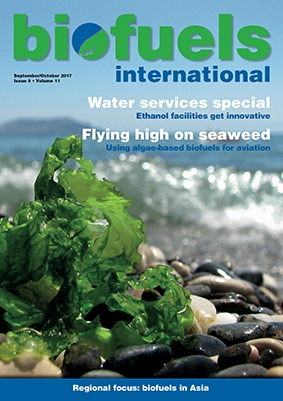Volume 11, Issue 5
Published: September 12, 2017
Current price index
The continued regulatory uncertainty surrounding European Biodiesel has now taken effect and is starting to sap liquidity from the market. The proposed duty reductions on Argentinian and Indonesian imports,...
US biodiesel and RFS compliance after court ruling
Soy-methyl ester biodiesel spot prices increased sharply mid-summer fromearly year lows, climbing above $3 (€2.52) gallon in July and holding there after early year weakness on concern that federal...
Untapped potential
The potential for biofuels in Asia remains enormous but progress in the practical development of the region and its creation of a working distribution network remain painfully slow.“Not a lot has...
Flying high on seaweed
Biofuels are considered necessary to decarbonise parts of the economy where no alternatives are possible, notably aviation where electrification is not yet available. Europe today meets 90% of its renewable...
The green stuff
In Hilo, Hawaii, Agricultural Research Service (ARS) plant pathologist LisaKeith is leading an effort to produce biodiesel using a type of green algae known as Auxenochlorella protothecoides (formerly...
Know your limits
Maximising operational effectiveness is as important to ethanol plant managers around the world as it can be challenging. Their efforts may include water-centric strategies, such as minimising water use,...
Water, water everywhere and a drop of the Internet of Things
One of the major challenges facing the US’ bioethanol sector is its need to reduce water and its increasingly outdated infrastructure, as digitisation and the rise of Internet ofThings (IoT) technology...
Counting the costs
Reverse Osmosis (RO)is a process that usesa semi-permeable membrane to remove about 99% of total dissolved solids (TDS) from a water source. The commercial application of this equipment dates back to 1959.Innovation...
All means necessary
The road transport sector is a major source of Europe’s emissions o fgreenhouse gases (GHGs)contributing to global warming. In addition, the sector also generates harmful local emissions, such as...
Making more with less
Being open to new technologies and innovations can help ethanol plants to meet their sustainability goals and operate efficiently and effectively. A number of companies, including US bioethanol producer...
Home and dry
It has never been more essential for ethanol plant sto maximise throughput. ICM is helping plants do this through its ethanol dehydration systems. Here, Liz Gyekye catches up with Kory Wilson, director...
Moving water from ethanol
In ethanol production, one of the last, essential steps is to dehydrate the ethanol to over a 99% purity. Achieving such high levels of ethyl-alcohol purity cannot be accomplished by distillation alone...
Reducing emissions from transport
In recent months there has been questioning of the government’s seemingly wavering commitment to environmental issues, highlighted in the delay of publishing its Air Quality Report, and then on its...
Opening instead of closing doors
Palm oil has caused a great deal of controversy in recent months. Used primarily in food production but also in cosmetics and as fuel, critics have questioned the cheap vegetable oil’s sustainability....
More transparency for bio processes
In anaerobic fermentation plants, there is often a lack of reliable automated monitoring systems.Operators are faced with many influencing factors, but many of these values are only available aslaboratory...
Making hay with the opportunities offered by CO2
The long-term sustainability of first-generation ethanol facilities, through advanced biofuels plants, is realised by making money from all of the by-products. Of course, CO2 is one of the leading components...







